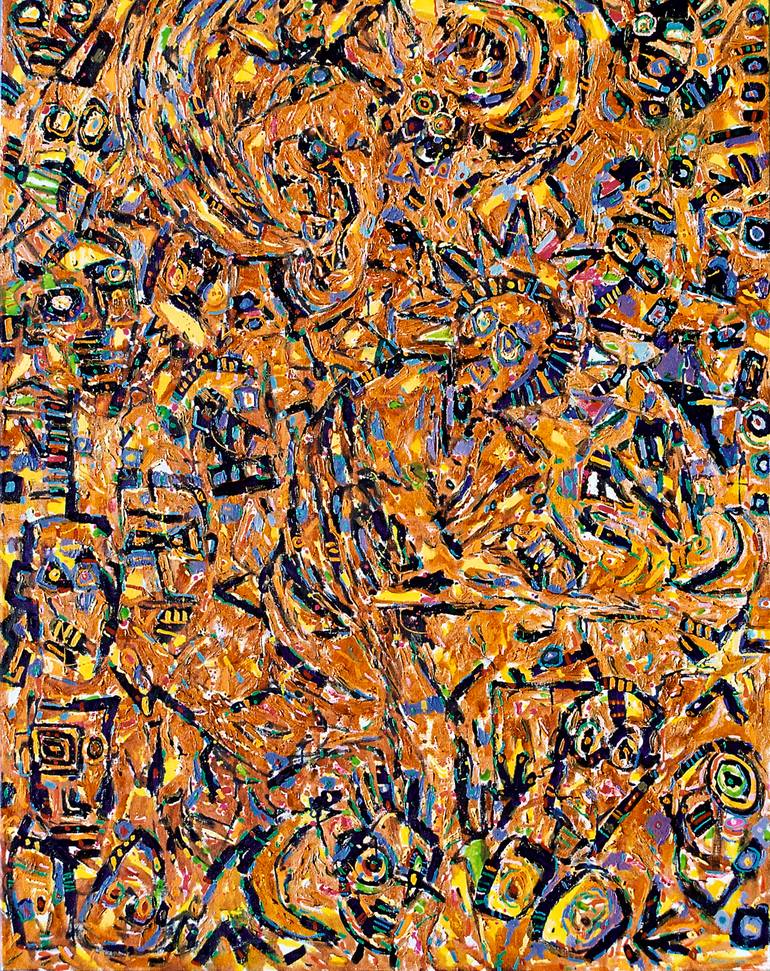


VIEW IN MY ROOM
(302) "St.Matthew and Angel" Painting
Poland
Painting, Acrylic on Canvas
Size: 44 W x 57 H x 1 D in
Ships in a Crate
Artist Recognition

Artist featured in a collection
About The Artwork
146x114cm The Temptation of St. Anthony Biblical subjects and saints' lives do more than inspire exclusively religious or mystic art. The Bible, witch after all is but one of many attempts by mankind to discover the Truth, can also serve as a reason for painting the contemporary world. Marc Rothko, the great contemplative of the twentieth century, the creator of an amazing and wonderful chapel in Texas, was undoubtedly a mystic, even though it is difficuft to find a single saint in any of his paintings. Memling, on the other hand, failed in his painting to create the necessary guff separating the Kingdom of Heaven from the world of men. His religious scenes, full of poise and elegance as they are, evoce all the smells, tastes and sounds of his time, the waning Middle Ages and the fast-approaching Renaissance. Finally, the sentimentalized and idealized image of Christ and the Saints, which still survives in the broad popular area of so-called religious art, was the creation of the nineteenth century. The pictures of Krzysztof Pająk, under the collective title of "The Temptation of St. Anthony", are closer to the profane view of Memling than the philosophical, mystic world of Rothko. Today, with the collapse of rigid moral values and the world having become more colourful than ever (the division between "good* and "hair, "black" and "white", finally blurred), the absorbing subject of the temptation of St. Anthony can stand as a symbol of our own waning century. The Evil One still tempts modern man, in all manner of seductions. The choice of a religious subject confirms the link with earlier artists and their fascination with biblical themes; such a choice also confirms Pająk's delight in both pictorial and thematic diversity. In the middle of our modern chaos and confusion, the challenge inherent in painting angels and saints exists. It is the challenge of not painting them in a manner reminiscent of a century, the nineteenth, now consigned safety to the past. In Pająk's painting, angels, saints and devils (not to mention unidentified biblical beasts) lead the happy lives. Bv of creatures familiar with both pop art and exotic civilizations. His "cities" represent our longing for the archetypal lost paradise, which in Pająk's case is the lost, mythical city of Atlantis. Sparkling and full of rich colour, Pająk's "Last Supper", "St. Matthew and the Angel", 'Pieta', Five Minutes to the Flood" and 'Temptation of St. Anthony" are as sensual as the Bible and only abstract on the surface. Pajak belongs to those artists who do not belive in pure abstraction. Those pictures of his which feature concentra¬tions of streets and "antique" buildings (such as his biblical "Exodus from Egypt") are in no way abstract Hfe ancient cities, like all great cities, are seats of good and evil, and in this respect they are supremely hM~" and highly seductive. In the same way as the Bible records a great many diverse events, so Pająk's pictures, not unlike mosaics, contain a great many vibrating colours sparkijiag with inner light. In his cities the primary colours of neon lights, so often a feature of the film world, create a sense of distance and serve to keep the viewer at arm s length. The biblical scenes, on the other hand, have the quality of rich oriental carpets which almost ask to be touched. Less disciplined and less elegant than the cities, they are full of a joy derived from a sampling of the world with all five senses. Even the sense of hearing is present in Pająk's highly musical refigjoas paintings. Modern art, working as it does in various media, often brings together image and sound. But there is noting original in this, for painting and music have always been close friends. Goya, during the final thirty** yens of his life, worked in complete silence, rejected bright and vivid coloyts, and used instead soft, muted shades. Pająk values simplicity above all else, holding it to be a sure form of greatness. He refuses to wfr w» medium with another and remains loyal to canvas and paint. He tempts his a. Anthony wife MM eotoers ringing like bells. And if in the end the saint isn't tempted, it is his sight whfch te at ta*. St. MfcNf Wśk. after all, be colour blind. Milena Dabić
Details & Dimensions
Painting:Acrylic on Canvas
Original:One-of-a-kind Artwork
Size:44 W x 57 H x 1 D in
Frame:Black
Ready to Hang:Not applicable
Packaging:Ships in a Crate
Shipping & Returns
Delivery Time:Typically 5-7 business days for domestic shipments, 10-14 business days for international shipments.
Handling:Ships in a wooden crate for additional protection of heavy or oversized artworks. Crated works are subject to an $80 care and handling fee. Artists are responsible for packaging and adhering to Saatchi Art’s packaging guidelines.
Ships From:Poland.
Customs:Shipments from Poland may experience delays due to country's regulations for exporting valuable artworks.
Have additional questions?
Please visit our help section or contact us.
Poland
1956 Warsaw, Poland. I am a painter, as well as designer and a photographer. More than 40 individual exhibitions. Participated in more than 250 group exhibitions, Participated in 60 charity auctions.
Artist Recognition

Artist featured by Saatchi Art in a collection
Thousands Of Five-Star Reviews
We deliver world-class customer service to all of our art buyers.
Global Selection
Explore an unparalleled artwork selection by artists from around the world.
Satisfaction Guaranteed
Our 14-day satisfaction guarantee allows you to buy with confidence.
Support An Artist With Every Purchase
We pay our artists more on every sale than other galleries.
Need More Help?